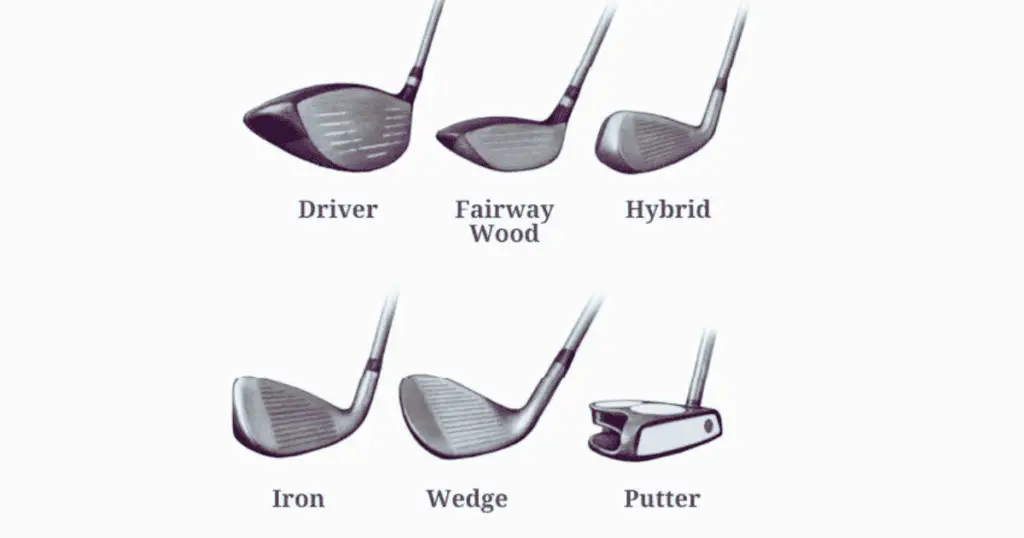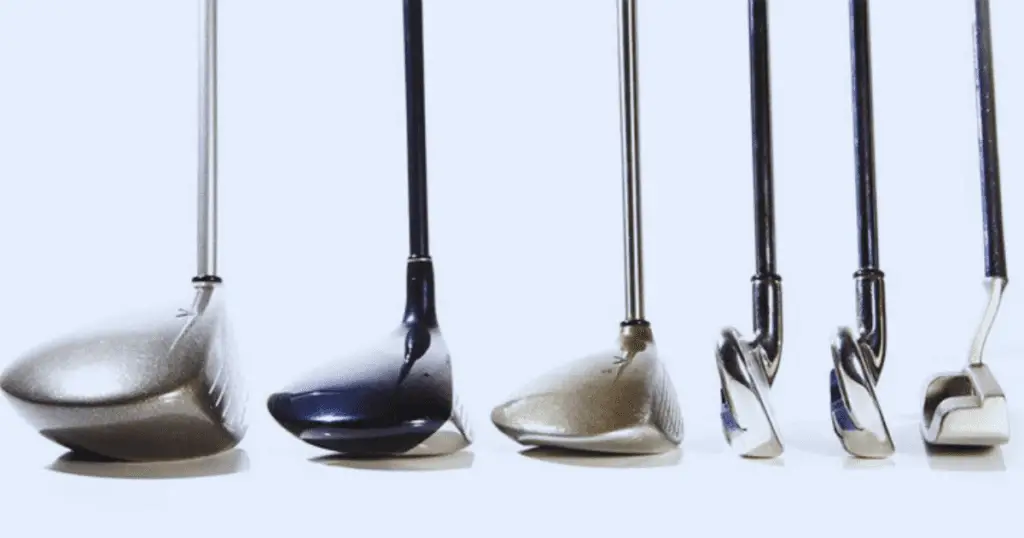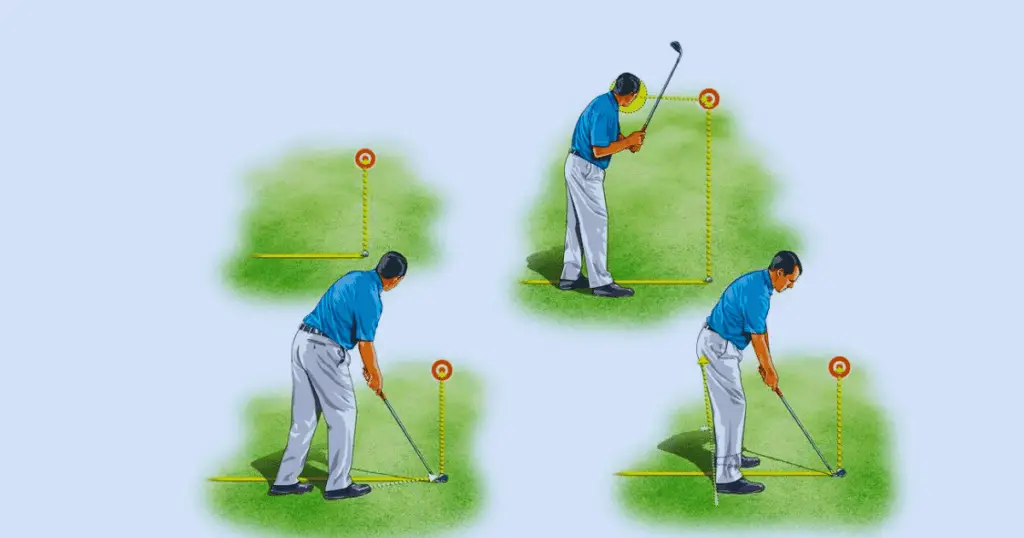Introduction
Welcome to the ultimate guide on golf club types. If you’re a golf enthusiast looking to enhance your game or a beginner to dive into this fantastic sport, you’ve come to the right place. Golf clubs are the indispensable tools that every golfer needs to navigate the greens effectively. In this comprehensive article, we’ll walk you through the diverse array of golf club types, offering tips, and recommendations to help you choose the best set for your game.
The Essential Golf Club Types

Driver:
The driver, also known as the 1-wood, is designed for maximum distance off the tee. With a large head and a long shaft, it’s engineered to deliver powerful drives, making it ideal for long par-4s and par-5s.
- Average Distance: 200-250 yards for beginners, 250-300 yards for intermediate players, and 300+ yards for advanced golfers.
- Use: Off the tee on longer holes to achieve maximum distance.
Irons:
Irons come in various numbered configurations, ranging from 1-iron to 9-iron, each with a different loft angle. Irons are versatile clubs used for a variety of shots, including approach shots, chip shots, and long-distance shots from the fairway.
- 3-Iron to 5-Iron:
- Average Distance: 130-200 yards.
- Use: Longer approach shots or tee shots on shorter par-3 holes.
- 6-Iron to 9-Iron:
- Average Distance: 90-150 yards.
- Use: Mid-range approach shots and shots from the fairway.
- Pitching Wedge (PW):
- Average Distance: 80-130 yards.
- Use: Approach shots from shorter distances, often with higher loft.
Putter:
The putter is perhaps the most important club in your bag, as it’s used on the putting green to put the ball into the hole. Putters come in many designs, even blade putters and mallet putters, catering to different preferences in feel and alignment.
- Short putts, typically inside 6 feet, are considered critical for scoring well in golf, and mastering these distances is essential for success on the greens.
- Longer putts, beyond 10 feet or more, require greater accuracy in reading the green’s break and speed control to sink successfully.
Wedges:
Wedges are specialized clubs designed for short-distance shots around the green and out of hazards. They include sand wedges, lob wedges, and gap wedges, each offering unique loft angles and bounce characteristics to help you navigate tricky lies and tight pin positions.
- Gap Wedge (GW):
- Average Distance: 70-110 yards.
- Use: Shots requiring a specific distance between pitching wedge and sand wedge.
- Sand Wedge (SW):
- Average Distance: 60-100 yards.
- Use: Shots from bunkers and approach shots with high loft.
- Lob Wedge (LW):
- Average Distance: 40-80 yards.
- Use: Shots requiring a high trajectory and short carry distance, such as over hazards or onto elevated greens.
Hybrid Clubs:
Hybrid clubs combine the best elements of irons and fairway woods, offering forgiveness and versatility. They’re particularly useful for long approach shots and shots from the rough, providing a higher launch and softer landing than traditional long irons.
- Average Distance: Varies depending on loft and player skill level, typically ranging from 150-220 yards.
- Use: Versatile clubs suitable for a variety of situations, including long approach shots and shots from the rough.
Fairway Woods:
Fairway woods, such as the 3-wood and 5-wood, are designed for long-distance shots and rough. They feature a shallow face and a low center of gravity, making them easier to launch off the turf and achieve optimal carry distance.
- 3-Wood:
- Average Distance: 180-250 yards.
- Use: Long shots from the fairway or tee on shorter par-4 or par-5 holes.
- 5-Wood:
- Average Distance: 150-220 yards.
- Use: Similar to the 3-wood but with slightly less distance.
Utility Clubs:
Utility clubs, also known as rescue clubs or hybrid irons, bridge the gap between irons and fairway woods. They’re versatile clubs that excel in various situations, offering forgiveness and playability from a variety of lies.
Average Distance: Similar to hybrid clubs, offering versatility and forgiveness from various lies and distances.
Golf Drivers Producer
Here are some well known golf driver producers along with approximate price ranges for their products:
| Providers | Prices | Description |
|---|---|---|
| Titleist | Price Range: $300 to $550 | Titleist offers a range of high-quality drivers known for their performance and precision engineering. |
| Taylor Made | Price range: $300 to $600 | Taylor Made is a leading manufacturer of golf clubs, including drivers known for their innovative technologies and adjustability features. |
| Callaway | Price Range: $250 to $550 | Callaway produces a diverse lineup of drivers designed to cater to players of all skill levels, from beginners to professionals. |
| Ping | Price Range: $300 to $500 | Ping is renowned for its engineering expertise and commitment to custom fitting, offering drivers designed for optimal performance and forgiveness. |
| Cobra | Price Range: $250 to $500 | Cobra’s drivers are known for their innovative designs and performance-enhancing features, making them popular choices among golfers seeking distance and accuracy. |
| Mizuno | Price Range: $300 to $500 | Mizuno’s drivers are characterized by their classic aesthetics and precision craftsmanship, appealing to golfers who prioritize feel and workability. |
| Srixon | Price Range: $200 to $400 | Srixon produces drivers known for their combination of performance and affordability, making them popular choices among amateur golfers. |
| Wilson | Price Range: $100 to $ 300 | Wilson offers a range of drivers designed for players of all abilities, with a focus on delivering distance and forgiveness at an affordable price point. |
Conclusion
In conclusion, golf club types play a pivotal role in shaping your performance the game. By understanding the nuances of each club type and selecting the right set for your game, you can elevate your skills and confidence on the course. Whether you’re driving off the tee, navigating the fairway, or sinking putts on the green, having the right drivers in your bag can make all the difference. So, what are you waiting for? Explore the world of golf club types and take your game to new heights.
Golf club types list?
Drivers
Iron
Wedges
Putters
Hybrid Clubs
Fairyway Woods
Utility Clubs
Golf clubs types and uses?
Certainly! Here’s a concise list of golf club types:
Driver: Designed for maximum distance off the tee.
Irons: Versatile clubs used for approach shots and long distance shots.
Putter: Essential for rolling the ball into the hole on the green.
Wedges: Specialized clubs for short distance shots around the green and out of hazards.
Hybrid Clubs: Combine elements of irons and fairway woods for forgiveness and versatility.
Fairway Woods: Used for long distance shots from the fairway and rough.
Utility Clubs: Also known as rescue clubs or hybrid irons, offering versatility and forgiveness.
Golf club types and distances?
Driver: Average Distance: 200-250 yards for beginners, 250-300 yards for intermediate players, and 300+ yards for advanced golfers.
Irons: 3-Iron to 5-Iron:Average Distance: 130-200 yards. 6-Iron to 9-Iron:Average Distance: 90-150 yards. Pitching Wedge (PW):Average Distance: 80-130 yards.
Putter: Short putts, typically inside 6 feet, Longer putts, beyond 10 feet or more.
Wedges: Gap Wedge (GW):Average Distance: 70-110 yards. Sand Wedge (SW):Average Distance: 60-100 yards. Lob Wedge (LW):Average Distance: 40-80 yards.
Hybrid Clubs: Average Distance: Varies depending on loft and player skill level, typically ranging from 150-220 yards.
Fairway Woods: 3-Wood:Average Distance: 180-250 yards. 5-Wood:Average Distance: 150-220 yards.
Utility Clubs: Average Distance: Similar to hybrid clubs, offering versatility and forgiveness from various lies and distances.
Golf club names?
Driver
Fairway Wood (e.g., 3-wood, 5-wood)
Hybrid
Irons (e.g., 3-iron, 4-iron, 5-iron, 6-iron, 7-iron, 8-iron, 9-iron)
Wedges (e.g., Pitching Wedge, Gap Wedge, Sand Wedge, Lob Wedge)
Putter
- Joel Dahmen Career Earnings - March 29, 2024
- Golf Club Types - March 7, 2024
- Chi Chi Rodriguez Driving Range - February 9, 2024


